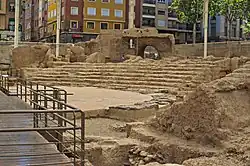| Teatro romano de Zaragoza | |
|---|---|
| Native name Spanish: Teatro romano de Zaragoza | |
 | |
| Location | Zaragoza, Spain |
| Official name | Teatre romano |
| Type | Non-movable |
| Criteria | Monument |
| Reference no. | RI-51-0010689 |
 Location of Teatro romano de Zaragoza in Spain | |
The Roman Theater of Zaragoza (formerly Caesaraugusta) is a theater from the Roman era, built in the first half of the 1st century AD, in the Age of Tiberius and Claudius. It had a capacity of 6,000 spectators (in a city where only lived 18.000 people[1]) and followed the model of the Theatre of Marcellus in Rome. It was active until the third century.
Its materials were used to build walls and other buildings. In 1973, archeological excavations uncovered it. It can currently be visited within the framework of the Cesaraugusta Theater Museum. It was declared Bien de Interés Cultural in 2001.[2]
History
The construction of the Roman theater of Caesaraugusta began in the early 1st century during the reign of the Roman Emperor Tiberius. It was completed under the rule of Emperor Claudius by the mid-1st century AD. Covering an area of 7,000 square meters (with a diameter of 106 meters), it ranks as one of the largest theaters in Roman Hispania. The theater could accommodate approximately 6,000 spectators in a city with a population of around 20,000 inhabitants.[3]
Technical Features
Unlike other theaters that utilized the natural slopes of the land, this building was constructed on flat ground using 'opus caementicium'. It was modeled after the Theatre of Marcellus in Rome, featuring a design of concentric rings with radial walls between them. These walls formed the cavea, or seating tiers, which were then covered with marble slabs, as was the orchestra.
The facade was adorned with ashlar blocks in the 'opus quadratum' style, rising to an external height of three stories and twenty-two meters. The theater boasted a unique, independent entrance from the central door of the facade directly to the orchestra. This path ran perpendicular to the stage or scena and served as a central axis for the theater, exclusively for authorities to directly access their reserved seats in the orchestral semicircle. This special entrance can also be seen in theaters in Turin and Minturno. However, it stands out as unique among the theaters of Roman Hispania. This design choice might be attributed to the variety of performances, not just dramatic, that took place within.[4]
Transformation and Rediscovery
The theater's decline began in the 3rd century when stones were repurposed to fortify the city walls and other constructions. As a result, only the Roman concrete structure remains visible today.
Over the years, the theater was buried beneath subsequent constructions. It remained obscured until the 1970s when excavations brought it back into the light. Following its rediscovery, it has been refurbished for public visits and now houses a museum that displays and interprets the archaeological finds uncovered.
Visitors can view the remnants of the seating tiers and stage via walkways. These remnants are protected under a large translucent polycarbonate cover. Adjacent to the archaeological remains, a building has been restored to house the Interpretation Center. This center acquaints visitors with the history of the theater, the dramatic genres, and the social and political life of the era.[5]
See also
References
- ↑ "Teatro Romano de Zaragoza". Gobierno de Aragón (in Spanish). Retrieved November 3, 2017.
- ↑ VV. AA., Renovación del Plan Integral del Casco Histórico de Zaragoza 2005-2012, Zaragoza, Gerencia Municipal de Urbanismo del Ayuntamiento de Zaragoza, page 65.
- ↑ Teatro Romano de Zaragoza, Gobierno de Aragón (2017), page 12.
- ↑ Miguel Beltrán Lloris, El teatro de Caesaraugusta. Estado actual de conocimiento, (in Spanish) vol. 2, 1993, pgs. 93-118.
- ↑ Francisco de Asís Escudero and María Pilar Galves, Edificios de espectáculos, (in Spanish) L'erma di Bretschneider, 2007, vol. 4, pgs. 57-70. ISBN 9788882653986.